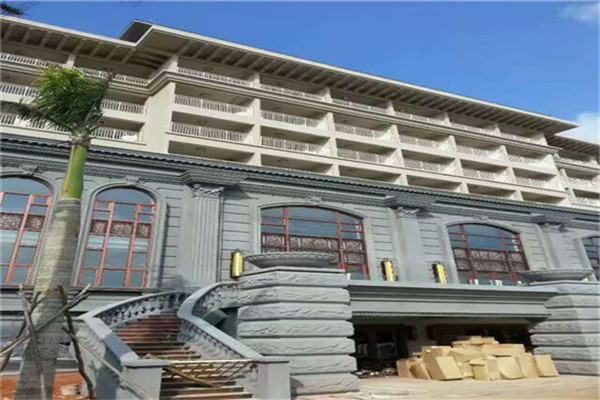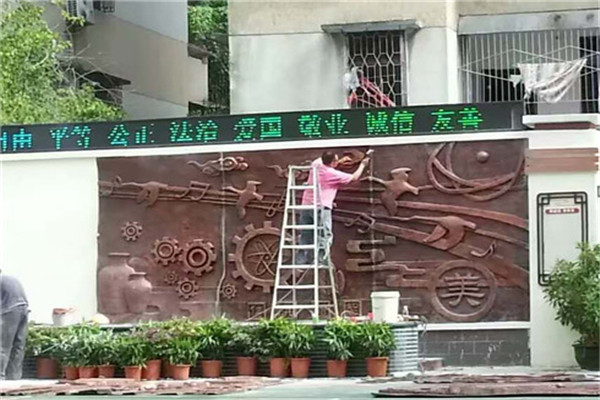
Circular sculpture, also known as three-dimensional sculpture, refers to non compressed three-dimensional sculpture that can be viewed from multiple directions and angles. Sculpture is the overall expression of art on the sculpture. The viewer can see all sides of the object from different angles. It requires the sculptor to carve from the front, back, left, right, top, middle and bottom. The techniques and forms of round sculpture are also varied, including realistic and decorative, concrete and abstract, indoor and outdoor, shelf and large city sculpture, colored and non colored, etc; The contents and themes of the sculptures are also rich and colorful, which can be characters, animals or even still life; The materials are more colorful, including stone, wood, metal, clay, gypsum, textiles, paper, plants, rubber, etc. It is mostly used in fountains, gardens and indoors. Because the round sculpture works are very three-dimensional, vivid, lifelike and vivid, the selection of stone materials is strict. First of all, we should design the shape of the sculpture, and pay special attention to the fact that the sculpture must have a proper proportion with the real object from length to width to thickness.

Button carving refers to the carving of the buttons on the upper part of the seal. It belongs to the category of round carving and has a rich three-dimensional sense. However, compared with round carving, it has three significant characteristics. First, the image is small, limited to the size of the seal, which is generally less than 10 cubic centimeters; The second is to show only the upper part of the object, rather than the round sculpture, which needs all-round performance; In addition, the performance content of button carving is mostly animals, especially animals in ancient legends, such as chi, lion, dragon, tiger, exorcism, taotie, etc. Therefore, button carving is also called "animal button". The history of button carving is linked with seals. Only seals can make buttons. According to relevant historical research, the earliest seal started in the Zhou Dynasty, more than 3000 years ago. The original seal is a symbol of power and status, and is a special item for princes, generals and ministers, and Dada dignitaries. The original seal button was also very simple and simple, just drilling a small hole on the top of the seal to wear strong ties for carrying, so the seal button is also called "seal nose". With the continuous development of history, a strict hierarchy has emerged in the materials and buttons of seals according to the different positions and official titles of users. For example, the official seal of the Qin Dynasty, in addition to using gold, silver, copper and other materials to distinguish the level of the official seal, also distinguishes the decoration of the button. In the Han Dynasty, the emperor used tiger buttons with jade seals, the crown prince, the lieutenants, the prime minister, the lieutenant, the sangong, and the left and right generals used gold seal tortoise buttons, and the officials of the two thousand stone Dai Lu used bronze seal elephant buttons Since then, the buttons used by all dynasties, from the monarch down to the officials of various products, were mostly chi, lion, dragon, phoenix, tiger, exorcism, taotie, unicorn, camel, bird, claw, bear, bat and other animals in the zodiac, depending on their positions.

Sculpture refers to the ornamental and memorial objects that are carved to beautify the environment or for commemorative purposes, and have certain meanings, symbols or pictographs. Sculpture is a kind of plastic arts. It is also called sculpture, which is the general name of three creation methods: carving, carving and sculpture. It refers to the art of using various plastic materials (such as gypsum, resin, clay, etc.) or hard materials (such as wood, stone, metal, jade, agate, aluminum, glass fiber reinforced plastic, sandstone, copper, etc.) that can be carved or carved to create a visual and touchable artistic image with a certain space to reflect social life and express the artist's aesthetic feelings, emotions, and ideals. The lines can reduce the carved material through carving, while the plastic can achieve the purpose of artistic creation by adding plastic material.

In the process of tourism development, landscape already exists. From the domestic Terracotta Warriors and Horses, the Shinto of the Ming Tombs, Dunhuang Grottoes, etc., a large number of tourists at home and abroad have been attracted. In recent years, Beijing Shijingshan International Sculpture Park, Miyun Legal Park, Changchun Sculpture Park, and OCT Sculpture Park, a number of urban theme parks, are also attracting tourists from all walks of life. Foreign theme sculpture parks such as Vigeland Sculpture Park, Seattle Olympic Sculpture Park, South Korean Sex Sculpture Park, etc. also attract many tourists. Here, the theme sculpture parks and similar tourist areas that have been well used in tourism development are classified to find the commonalities and differences among them, so as to provide reference for the application of sculpture landscape in tourism development.

It is a three-dimensional plastic art to use certain material materials to produce works of art with solid image. Because the production methods are mainly sculpture and molding, it is called sculpture. According to the production process, sculpture can be divided into two categories: sculpture and sculpture. Subdivision is divided into carving, carving, molding, chiseling, carving, casting and other skills and techniques. According to genre, sculpture can be divided into memorial sculpture, urban garden sculpture, sculpture, tomb sculpture and exhibition sculpture. According to the style, sculptures can also be divided into head portrait, bust portrait, bust portrait, full body portrait, group portrait, etc. According to the technique and form of expression, sculpture can be divided into three categories: round sculpture, relief sculpture and openwork sculpture. Round sculpture, also known as "muddy sculpture", is a three-dimensional sculpture that is not attached to any background and can be viewed from all sides. The round sculpture is characterized by a solid image standing in space. When creating it, one must take into account its sense of volume and weight. When shaping the image, one must also take into account that people watch it from different angles. Relief, also known as "relief", is to carve a convex artistic image on the plane. According to the different degrees of surface relief, relief can be divided into high relief (high and low relief, deep relief) and low relief (low and low relief, shallow relief). The openwork is between the round sculpture and the relief sculpture. On the basis of the relief sculpture, it is made by hollowing out the background, but it does not leave the plane, just like a round sculpture attached to the plane background.

According to the materials, rockeries can be divided into earth mountains, stone mountains and earth rock mountains (earth mountains and stone mountains and stone mountains and earth rock mountains); according to the construction method, rockeries can be divided into mountain building (block building earth mountains), mounding mountains (mountains are formed by mounding rocks), mountain chiseling (mountains are formed by digging natural rocks) and plastic mountains (traditionally molded by lime slurry, modern rockeries are molded by cement, brick, steel wire mesh, etc., referred to as plastic stone rockeries in the industry. high quality Sculpture Design The rockery can be divided into garden hill, hall hill, lou hill, pavilion hill, shufang hill, pool hill, indoor hill, wall hill and beast hill according to its location and use in the garden. The combination form of rockery is divided into mountain body and water body. Sculpture Design Price Hainan Sculpture Mountains include peaks, ridges, peaks, ridges, valleys, gullies, hillocks, walls, rocks, hills, caves, docks, foothills, platforms, walkways, and plank roads; water bodies include springs, waterfalls, ponds, streams, streams, pools, rocks, and stilts. The landscape should be integrated to complement each other.






